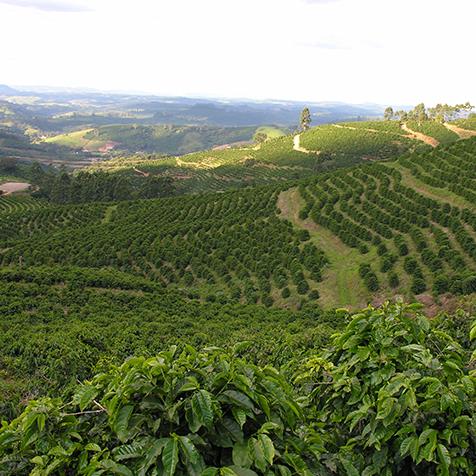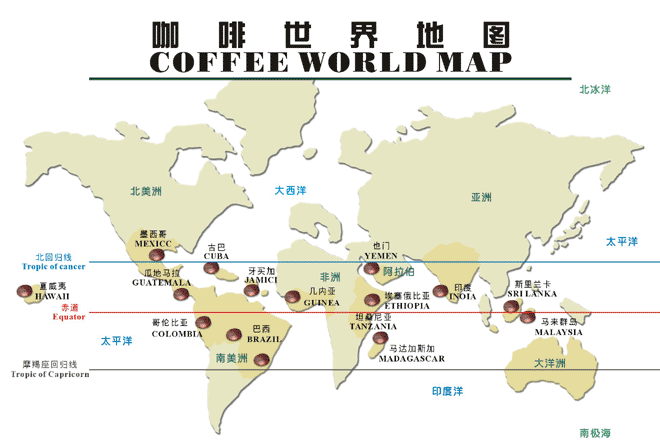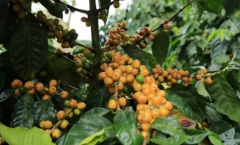Interpretation of the flavor characteristics of individual coffee beans from all over the world
Coffee trees grow in tropical or subtropical agricultural gardens centered around the equator and called coffee belts.

In addition, growing coffee also requires daylight and proper shade, which is most suitable for planting on fertile soil or volcanic ash soil. Therefore, the origin of coffee is widely distributed in South America, Central America, the West Indies, Asia, Africa, Arabia, the South Pacific and Oceania. Such as Ethiopia and Tanzania in Africa, Brazil, Colombia, Jamaica, Guatemala, Mexico, Honduras, Costa rica in Central and South America, Vietnam and Indonesia in Southeast Asia, are all major coffee producers.
In terms of production, Central and South America accounts for about 60 per cent of the world's coffee production, Africa and Arabia account for about 20 per cent, and the remaining 20 per cent are distributed in Asian countries and islands.
In South America, Brazil accounts for 30-50% of the world's output, while Colombia accounts for 10-20%. At present, the coffee production of Vietnam in Asia has surpassed that of Colombia, and Indonesia has become the fourth largest coffee producer in the world.
Central and South America
Characteristics of taste: balanced, moderate acidity and mellow taste
Central and South America is the largest coffee producing area in the world, and there are countless boutique coffee here. Take Colombia, Guatemala or Brazil as an example, good coffee is enough to make people dazzling. What is the resource advantage that makes Central and South America so good?
French naval officer GabrielMathieudeClieu experienced difficulties and obstacles to bring the first coffee sapling from Africa to the Latin American island of Martinique, which was the origin of coffee cultivation in Latin America. Because France was under the Bourbon dynasty, Arabica coffee grown in Latin America had another name, bourbon, which is now famous in the coffee industry. Bourbon is now an important branch of coffee in Arabica. The overall flavor of Latin American coffee is famous for its balance, and all the flavors in the coffee can be found in Latin American coffee. The widespread use of wet treatment of raw beans is also one of the characteristics of Latin American coffee, good processing also makes its beans larger and more uniform than African coffee, and the defect rate is lower.
Representative:
Colombia is one of the largest producers of high-quality coffee in the world, a bright pearl in the world coffee map and a coffee land blessed by God. Arabica coffee is grown on steep slopes in the foothills, which are picked and washed by hand.
El Salvador coffee is also extremely high quality, and unique flavor: a strong sense of balance, fresh and lively, mild taste, sweet and pleasant, can be described as "pure natural flavor". This is because of the fertile soil, suitable altitude, good climate, intergenerational planting techniques and tree species with fine pedigree.
Guatemala is a coffee producing area that can not be ignored and is a typical representative of coffee flavor diversity. SHB (hardest bean) in Guatemala is almost a well-known synonym for high-quality coffee. This is because there are more than micro-environmental climate, high mountains, the Pacific Ocean, the Atlantic Ocean, huge volcanic lakes, Mexican plains. And rich geographical and climatic resources.
Panamanian caffeine is famous in the world, and the reason is that it is closely related to Panama's unique physical and geographical conditions. Moderate curry body, smooth taste, delicate acidity, well-balanced taste value, coupled with subtle flavors such as caramel, chocolate, citrus and jasmine.
African coffee
Flavor characteristics: charming acidity
As the birthplace of coffee, African coffee plays an important role in the whole coffee industry. Although the commercial cultivation of coffee has been developed around the world for hundreds of years, the unknown wild coffee varieties in Africa are still the greatest treasure in the hearts of coffee researchers. African coffee is generally characterized by strong aroma and charming acidity, its sour brightness is lively and exhilarating, but the mellow African coffee is often slightly thin and the sweetness is not very prominent. African coffee due to drought and lack of water, mostly use the sun method to deal with raw beans, the bean shape is often uneven and beautiful, and the defect rate is high.
Representative:
Kenya grows high-quality Arabica coffee beans, which absorb almost the essence of coffee cherries, with a slightly sour, thick aroma, and are very popular among Europeans, especially in Britain. Kenya Coffee surpassed Costa Rican coffee and became one of the most popular coffees. With the aroma of mellow wine and flowers, the texture is full, small and round, because it is easy to roll in the pot, it can be roasted evenly, suitable for home baking. Signature coffee: Kenyan AA coffee, is the best in African coffee, thick and full-bodied, slightly acidic, smooth taste and slightly alcoholic flavor, AA represents Kenya's highest coffee beans.
Ethiopia is an agricultural country with a history and tradition of coffee origin. The place where the name "coffee" comes from is Kafa in the southwest, while the Sidamo place in the south is the main producing area, and Yega Xuefei is one of the southern producing areas of Sidamo. Eastern Highland Hara is as famous as the coffee name "Hara".
Ethiopia is an important coffee producing country with about 10,000 people engaged in coffee production and is a major exporter of Arab coffee beans in Africa. The high-quality coffee here is of excellent quality and is worth looking for. It has a soft taste, with wild flavor of wine, and slightly sour taste, unforgettable after drinking.
Asian coffee
Characteristics of taste: deep flavor and strong taste
When it comes to Asian coffee, the first impression of coffee lovers is often calm and calm. It is precisely because of the heavy nature of Asian coffee that it is very suitable to be used as a base when making Italian coffee. The raw coffee beans in Asia are generally processed by wet or semi-wet process. most of the raw beans are uniform, but the color of the beans treated by semi-wet method is darker. Asian coffee is generally characterized by thick flavor, strong sweetness and round taste, but slightly flat aroma and brightness.
Representative:
Coffee cultivation in Mantenin, Sumatra, began in the 18th century, when it was planted near Aceh province on the north side of Lake Tawar. For a few days, most of the Sumatran coffee area is located in the south of Lindong, Subu and Takengon coffee. Because there is little difference between planting areas, Sumatran coffee does not use the producing area as the distinguishing standard, but the way of picking and handling has a great influence on the flavor of the coffee. The famous "Golden Manning" is an excellent product after the Japanese strictly control these procedures.
Mantenin is one of the most suitable coffee beans for deep roasting in the world. One of the famous reasons is that its own characteristics will not disappear after deep roasting. Its thick flavor and low acidity make it very popular in Taiwan. In fact, the high quality mantenin is also very suitable for medium and shallow baking, which can show a good fruit flavor at this degree of baking.
The aroma of Java Manning Coffee is full-bodied and full-bodied, with clear high-quality acidity, high balance, and sometimes nutty flavor. In terms of appearance and quality, Java coffee is excellent, just like a woman's vaguely charming, charming and just right, memorable.
Papua New Guinea is an anomaly in Indonesian coffee. Coffee estates are numerous, large and small in scale, and most of the small estates produce washed organic beans with strong flavor but no local flavor. These small estates also produce a small amount of sun beans, which are more varied and delicate than water-washed beans; the taste of large manor coffee is more clean and delicate, but some people think that it has less personality. Basically, Babu coffee is lighter than java beans, somewhat similar to good Central American beans. Most of the coffee trees in the area come from the Tibica seed of the Jamaican Arabica bean, mixed with the Arabica bean from Tanzania.
Bali is mostly mountainous, with vertical and horizontal mountains, high in the east and low in the west, with four or five conical complete volcanic peaks, of which Mount Argonne (Bali Peak) is the highest point on the island. Nearby, there is the Badur active volcano that erupted in the year. The coffee in Bali is special, which is called Golden Coffee. It is made by grafting the roots of Arabica coffee trees and the branches and leaves of coffee grown by Robosta. It is famous for its golden color, rich aroma and low caffeine. Raw beans exude strong cantaloupe and tropical fruit aromas; the entrance flavor changes to the sweetness of pineapple and strawberry jam, showing smooth and rich acidity at medium and low temperatures, with aromas of handmade black sugar, delicate dark chocolate and hazelnut.

Important Notice :
前街咖啡 FrontStreet Coffee has moved to new addredd:
FrontStreet Coffee Address: 315,Donghua East Road,GuangZhou
Tel:020 38364473
- Prev

The different faces of coffee beans have long been changing personalities
Professional barista communication, please pay attention to coffee workshop (Weixin Official Accounts cafe_style) long-term placement of more than two or three bags of different varieties of coffee beans in the home, if added to the company, the total number should be maintained at about five or six bags. With a packet of about 200g, each cup of coffee with 20g beans, such an amount of more than two months to complete, and then look at the best coffee beans is actually
- Next

Coffee beans description of the flavor of Brazilian yellow bourbon boutique coffee beans
Among the many varieties of coffee in Brazil, yellow bourbon is one of the most outstanding varieties. Generally speaking, yellow bourbon changes from green to yellow to red, but the appearance of yellow bourbon only stays in yellow. The yellow bourbon, which grows at high altitude and is sun-treated, has an excellent flavor. Brazil Chacal Yellow Bourbon, Brazil, belongs to the Shenmu Manor in the South Minas region, due to the
Related
- Guji coffee producing area of Guji, Ethiopia: Humbela, Shakiso, Wulaga
- What is the most expensive variety of Qiloso in BOP multi-variety group?
- How to store the coffee beans bought home?
- Why are Yemeni coffee beans so rare now?
- Ethiopian Sidamo all Red Fruit Sun Sun Santa Vini Coffee beans
- SOE is mostly sour? What does it mean? Is it a single bean? what's the difference between it and Italian blending?
- Is Italian coffee beans suitable for making hand-brewed coffee?
- How to choose coffee beans when making cold coffee? What kind of coffee beans are suitable for making cold coffee?
- Just entered the pit to make coffee, what kind of coffee beans should be chosen?
- Can only Japan buy real Blue Mountain Coffee? What are authentic Jamaican Blue Mountain coffee beans?

